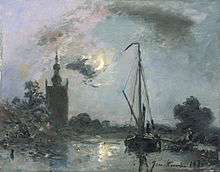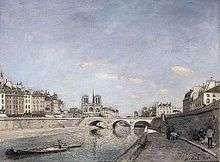Johan Jongkind
Johan Barthold Jongkind (3 June 1819 – 9 February 1891) was a Dutch painter and printmaker. He painted marine landscapes in a free manner and is regarded as a forerunner of Impressionism.

Biography


Jongkind was born in the town of Lattrop in the Overijssel province of the Netherlands near the border with Germany. Trained at the art academy in The Hague under Andreas Schelfhout, in 1846 he moved to Montparnasse in Paris, France where he studied under Eugène Isabey and François-Édouard Picot. Two years later, the Paris Salon accepted his work for its exhibition, and he received acclaim from critic Charles Baudelaire and later on from Émile Zola. He was to experience little success, however, and he suffered bouts of depression complicated by alcoholism.[1]
Jongkind returned to live in Rotterdam in 1855, and remained there until 1860.[1] Back in Paris, in 1861 he rented a studio on the rue de Chevreuse in Montparnasse where some of his paintings began to show glimpses of the Impressionist style to come. In 1862 he met in Normandy, in the famous ferme Saint-Siméon in Honfleur, with some of his artist friends, such as Alfred Sisley, Eugène Boudin, and the young Claude Monet, to all of whom Jongkind served as a mentor. Monet later referred to him as "...a quiet man with such a talent that is beyond words" and credited the "definitive education" of his own eye to Jongkind.[2] In 1863 Jongkind exhibited at the first Salon des Refusés. He was invited to participate in the first exhibition of the Impressionist group in 1874, but he declined.[3]
In 1878, Jongkind and his companion Joséphine Fesser moved to live in the small town of La Côte-Saint-André near Grenoble in the Isère département in the southeast of France. He died in 1891 in Saint-Égrève, in the same département. He is buried in the cemetery of La Côte-Saint-André. A street is named after him in the neighborhood of streets named after 19th- and 20th-century Dutch painters in Overtoomse Veld-Noord, Amsterdam.
Commemoration
On 2 June 2019, a statue of Jongkind made by Dutch sculptor Rob Houdijk was revealed in the Duifpolder between Maassluis and Vlaardingen alongside the Vlaardingertrekvaart canal, on the occasion of the 200th anniversary of his birth. [4] [5]At this spot, Jongkind must have made preparatory sketches of the Rechthuis van Zouteveen for one of his later etching ‘Les deux barques à voile’ from 1862. [6]
Subject and style
Jongkind's most frequent subject was the marine landscape, which he painted both in the Netherlands and in France. Many of his works depict the Seine, particularly the area near Notre-Dame Cathedral. He painted watercolors out-of-doors, and used them as sketches for oil paintings made in his studio.[2] His paintings are characterized by vigorous brushwork and strong contrasts. Like the 17th-century Dutch landscape painters of the 1. Golden Age of Dutch painting, he typically composed his landscapes with a low horizon, allowing the sky to dominate.[7][8]







 Fishing Boat 1878
Fishing Boat 1878
Paintings in Museums
- Rijksmuseum, Amsterdam
- Stedelijk Museum, Amsterdam
- Van Gogh Museum, Amsterdam
- Rijksmuseum twenthe, Enschede
- Gemeentemusem, Den Haag
- Kasteel het Nijenhuis, Heino
- Stedelijk Museum, Leiden
- Jan Cunen Museum, Oss
- Rijksmuseum Kröller-Müller, Otterio
- Museum Boymans-van Beuningen, Rotterdam
- Musée d'Orsay, Paris
- Musée des Beaux-Arts de Reims, Reims
- Musée de Grenoble, France
- Musée de Belfort, Belfort
- Ashmolean Museum at the University of Oxford, Oxford, UK
- Birmingham Museums & Art Gallery, UK
- Courtauld Institute of Art, London, UK
- Hunterian Museum and Art Gallery, University of Glasgow, Scotland
- National Gallery, London, UK
- (New Art Gallery, Walsall, UK
- Statens Museum for Kunst, Kopenhagen (National Gallery of Denmark)
- Museo Thyssen-Bornemisza, Madrid
- Cleveland Museum of Art], Ohio
- Dallas Museum of Art, Dallas
- Fine Arts Museums of San Francisco, San Francisco
- Metropolitan Museum of Art, New York City
- Museum of Fine Arts, Boston
- National Gallery of Art, Washington D.C.
- Currier Gallery of Art, New Hampshire
- Harvard University Art Museums, Massachusetts
- Indianapolis Museum of Art, Indiana
- Philadelphia Museum of Art, Philadelphia
- Princeton University Art Museum, New Jersey
- Los Angeles County Museum of Art, Los Angeles,
- Baltimore Museum of Art, Baltimore, MD
- Chi-Mei Museum, Taiwan
- Museo Nacional de Bellas Artes, Buenos Aires, Argentina
- Museu Nacional de Belas Artes, Rio de Janeiro, Brazil
- Museum de Fundatie in Zwolle
Selected paintings
Bibliographies
- Ankelle, Daniel (2011): Johan Jonkind: 75 Impressionist Paintings - Impressionisme, Angelke Publishing LLC, ASIN: B005VU2H1Y.
- Auffret, François ()2003): Jongkind 1819-1891 - Biographie Illustrée, Maisonneuve et Larose, Paris, ISBN 978-2-706-81766-3.
- Czymmek, Götz, Jaques Foucart John Sillevis u. a. (2004): Johan Barthold Jongkind: Ein Wegbereiter des Impressionismus, Ausstellungskatalog Richartz Wallraf Museum, Köln, ISBN 978-9-040-08924-4.
- Patin, Sylvie (2014): Jongkind - une Fascination pour La Lumière, Édition des Falaises, Rouen, ISBN 978-2-848-11229-9.
- Sillevis, John (2003): Jongkind Paintings, Bibliothèque De L'image, Paris, ISBN 978-2-914-66135-5.
Notes
- Oxford Art Online: "Johan Barthold Jongkind"
- Boorsch & Marciari, p. 246.
- University of California et al. 1974, p. 31.
- Jongkind zweeft in Duifpolder
- Johan Barthold Jongkind schittert in de polder
- Twee gezichten van Nr. 17: Het rechthuis van Zouteveen
- Musee d'Orsay website
- Reference is made to the following Dutch painters: Adriaen van Diest with Mediterranean port, Thomas Heeremans with Village inn near a river and Jacob van Ruisdael with Winter landscape. However, the horizon could fall even deeper, as seen in the painting The Gunfire by Willem van de Velde the Younger.
References
- Boorsch, Suzanne, and John Marciari (2006). Master Drawings from the Yale University Art Gallery. Yale University Press. ISBN 0300114338
- Hefting, Victorine. "Johan Barthold Jongkind", Oxford Art Online
- University of California, Riverside, Los Angeles County Museum, & University of California, Riverside. (1974). The Impressionists and the Salon (1874-1886) honoring the centennial of the first impressionist exhibition: California collections. Riverside, Calif. OCLC 1031907
External links
| Wikiquote has quotations related to: Johan Jongkind |
| Wikimedia Commons has media related to Johan Barthold Jongkind. |
- Association of the Friends of Jongkind (Société des amis de Jongkind)
- Biography of Johann Jongkind (includes a selection of his paintings)
- In the Steps of Jongkind in the Dauphiné (Dans les pas de Jongkind en Dauphiné)
- biography notes and dates of Jongkind, in the Dutch R.K.D. Archive, The Hague
- many free images of paintings, drawings and prints of Jongkind, in the Rijksmuseum, Amsterdam
- Jongkind's painting art in Musee d'Orsay, Paris